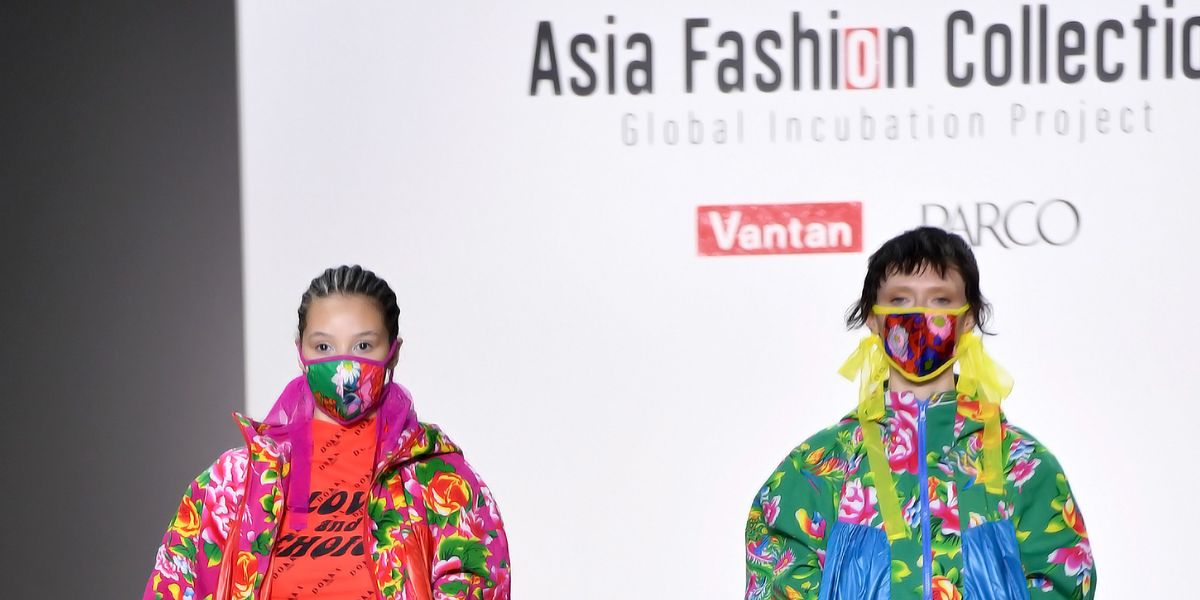
The Asia Fashion Collection returned to New York Fashion Week for the ninth year in a row, this time with a new set of fresh voices and amid calls for Asian representation in the fashion, art, and entertainment worlds, following a wave of hate crimes against the community in the United States.
In the past couple years, fashion industry leaders including Prabal Gurung, Jason Wu, Ji Oh, Alexander Wang, and Phillip Lim, have brought attention to the issue and voiced the need for more representation. In a Vogue UK op-ed last year, Gurung wrote, “The fashion industry has failed to represent us on so many levels, but more than that, it’s just unaware.” And Lim said in a statement, per WWD, that the work of fashion houses “should represent the world we want to see.”
This Fashion Week, the AFC answered the call by spotlighting a group of emerging designers, all of Asian descent. WooLeeX, Sung Ju, DOKKA vivid, Glenda Garcia, Yuuna Ichikawa, and Cocotono showed their latest collections—including both womenswear and menswear—at Spring Studios on February 15, and spoke to BAZAAR.com about how it felt to represent their cultures.
Ichikawa opened the show with a layered gray-and-white tulle dress, and followed with flared pants, big jackets—also with tulle—and a lot of drama. She said the concept behind her designs is always to “create shock” with contrasting colors and surprising shapes, and to dress “women who are strong and stand up for society.”
For Ichikawa, the challenge is not only to be included in the new wave of Asian designers being recognized these days, but to stand out for her own unique perspective. “I think the influence of Asia in the fashion world is immeasurable,” she told BAZAAR after the show, “but I don’t think Japanese women’s clothing designers have overcome the momentum yet, so I want to establish my own worldview and spread it not only to Japan, but also to the world.”
On the runway, fellow Japanese label DOKKA vivid flaunted big skirts in vibrant pinks, reds, and yellows, as well as ultra-embellished sweaters and dresses, floral headpieces, and long, hooded coats in intricate patterns. Models walked the runway carrying traditional Asian lanterns as bags, celebrating the designers’ heritage.
At one point, two models walked the runway side by side, wearing elegant but “spicy”—as designer Akiho Ka put it—monochrome looks: one in a warm pink spectrum, the other in cool blues.
“I met a lot of Asian creators of the same generation in this show. Even if we are from the same Asian regions, we have reaffirmed that we have completely different personalities and sensibilities,” Ka said. “Through the show, I was able to grasp the core of my brand more clearly.”
Sung Ju Lee, of Seoul-based label Sung Ju, brought streetwear-meets-activewear to the stage, with bright deconstructed sweat suits, balaclavas, oversized puffers, and fuzzy slippers with matching straight skirts.
Lee said it was a “great honor” for him to showcase his collection in New York, and his biggest motivation is knowing he’s taking steps for his community. “There are new talented designers and brands in Asia, and they can have a lot of influence,” he said.
WooLeeX designers Cynthia and Jerry Hsieh, based in Taiwan, have a similar view of Asian creatives’ potential. They said that after showing their collection in Taiwan and Tokyo, they were grateful to be able to “represent the Eastern (Asia) power of fashion” in the United States. “Bringing Asian culture to the world is one of the biggest plans of WooLeeX,” they said.
The duo graced NYFW with a collection of suits, blazers, and dresses in busy, colorful illustrated patterns paired with hoodies, shorts, long socks, and sneakers for the men and floral heels or sleek boots for the women. The pattern mixing would be dizzying if it wasn’t so incredibly well done.
Japanese designer Kotono Fukazawa of Cocotono also showed off a relaxed but polished aesthetic with his collection, except much more trippy and somehow also preppy. There were airy gingham blazers paired with matching shorts and varsity jackets paired with cropped pants. And the crowd let out an actual shared giggle upon seeing the models’ accessories: whiskey bottles, ice cream cones, and beer.
“The concept of Cocotono is LOL, which is based on the idea of oogiri, a form of comedy which is unique to Japan,” the designer said. “At the same time, I tried to make it easy for people overseas to understand the concept, including the styling.”
This was Fukazawa’s first time showing his designs outside of Asia, and he said he’s glad he’s part of the wave of Asian designers getting noticed in the United States.
Glenda Garcia, from Jakarta, Indonesia, made her NYFW debut with a string of black, white, and earth-toned looks with plenty of cutouts, belts, trenches, and rain boots. “First NYFW. A massive thank you to @asiafashioncollection for this incredible opportunity and the amazing show they’ve put together,” the designer wrote in an Instagram post after the show, sharing a video from the runway.
“I feel the Asia Fashion Collection and the wave of Asian talent being highlighted truly shows how global the industry is and how diverse cultural backgrounds and perspective enrich the landscape of fashion,” she told BAZAAR.
This content is created and maintained by a third party, and imported onto this page to help users provide their email addresses. You may be able to find more information about this and similar content at piano.io
Emerging Asian Designers Discuss Representation at New York Fashion Week
Source: Filipino Journal Articles

0 Comments